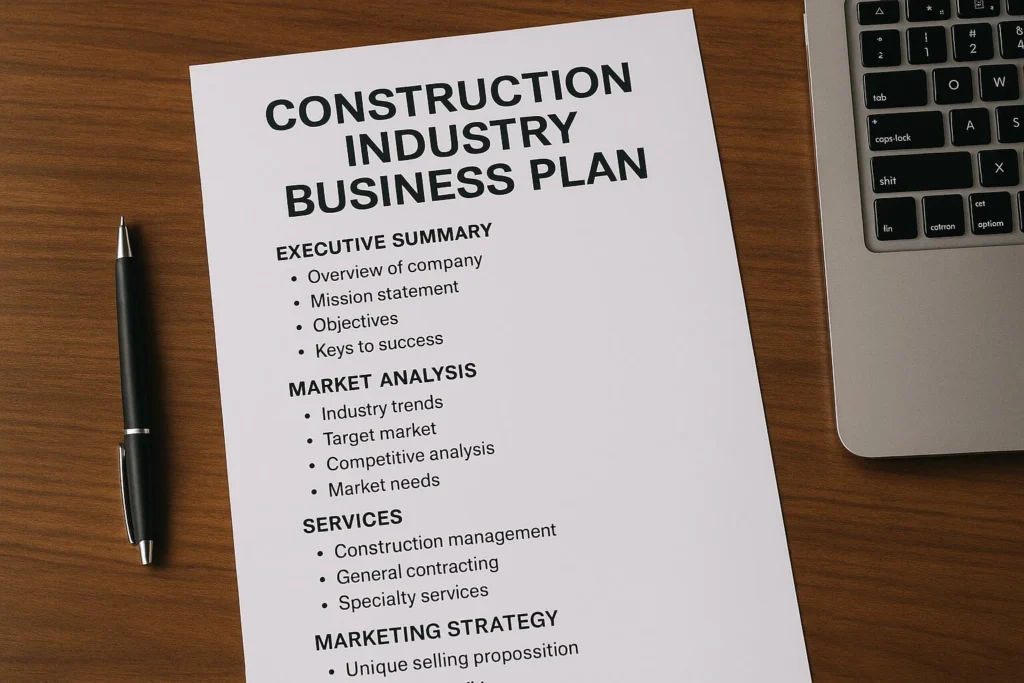Construction Industry Business Plan


Every construction business needs more than tools, trucks, and a skilled crew. It needs a clear map that shows where to go, how to compete, and how to last. A construction industry business plan gives that clarity. It turns ideas into steps, helps you speak to banks, and makes your team pull in one direction. With costs rising and deadlines tight, guessing is risky. Planning reduces surprises, sets goals, and guides daily choices on site and in the office.
It also helps you choose a niche, price work correctly, and prepare for safety and legal duties. Clients want reliable partners, not promises. A plan proves your methods, timelines, and budgets in simple terms. It captures what you build, where you operate, and how you win bids. Most of all, it protects cash by matching work to resources. That means starting projects you can finish well, and walking away from bad fits. The process is overall practical: write your mission, study market, creative services, plan marketing, and budget. Update the document often, and use it to train new people. When market shifts, a living plan helps you respond fast and stay steady. It keeps your business honest and focused.
Why a Plan Matters
Planning matters because construction is complex, capital heavy, and time bound. Without a written guide, owners bounce between bids, scramble for crews, and fight cash gaps. A good plan sets direction, trims waste, and keeps promises realistic. It helps you say no to bad jobs, and yes to profitable ones. Write down your goals, core services, target clients, and regions. Then match capacity to demand so schedules hold and crews stay safe. Use simple measures like win rate, average project size, and margin by job type. Review them monthly, and adjust before small problems grow.
The construction industry business plan also builds trust. Lenders want to see numbers and controls. Clients want to see process and proof. Vendors want to see that they will get paid on time. Documenting estimating steps, procurement rules, and change-order flow reduces disputes later. It also clarifies who decides, who checks, and who reports. That structure turns chaos into routine. In short, planning is not paperwork; it is risk control. By preparing for delays, weather, and supply shocks, you protect margins and morale. You also free leaders to focus on quality, safety, and relationships, which sustain growth. Clear plans turn effort into steady, repeatable results.
Key Points
- Define clear services, target clients, and regions early consistently.
- Match capacity to demand; protect schedules, cash flow always.
- Use metrics and dashboards to spot issues, act quickly.
- Combine web, referrals, partnerships to build deal flow reliably.
- Review results quarterly; update processes, training, and tools regularly.
What to Include
Include sections that cover identity, market, delivery, marketing, and money. Start with a crisp summary of who you serve and why you win. Describe the company form, leadership, licenses, and insurance. Define services, such as general contracting, renovations, design-build, or specialty trades. Explain your delivery model: estimating, scheduling, site control, safety, quality checks, and closeout. Show the tools you use for takeoffs, project management, and cost tracking. Then map the market. List segments, competitors, and trends you can realistically pursue. Back claims with simple data from past jobs or public sources.
The marketing plan should combine web presence, referrals, and local partnerships. Publish case studies, photographs, and client quotes that prove value. Spell out your sales pipeline, from lead to signed contract. Finally, present budgets, revenue forecasts, cash flow, and break-even timing. Note triggers for hiring and equipment purchases, so growth does not outrun cash. Tie all these parts together in a practical schedule for reviews and updates. When stakeholders read a construction industry business planbuilt this way, they see order, discipline, and transparency. They also see a builder who can manage risk, make decisions, and finish well. That inspires confidence and speeds approvals, bids, and lasting partnerships forward.
Money, Risks, and Scheduling
Cash makes or breaks builders. List start-up costs, monthly overhead, and job-level expenses in plain terms. Price work with realistic productivity and waste expectations. Track change orders, retainage, and warranty exposure so profit is not leaked later. Protect cash by aligning contract terms with schedule and procurement. Use deposits, progress billing, and lien waivers where allowed. Create a rolling thirteen-week cash forecast, and review it every Friday. Plan for risks: weather, permits, utility delays, and supply shortages. Assign owners, triggers, and responses for every risk. Schedule with buffers around crucial tasks, and lock long-lead items early.
Field teams should update the progress daily; office teams should reconcile costs weekly. Simple dashboards help everyone to see status at a glance. With this discipline, a construction industry business plan moves from paper to practice. It guides choices on which jobs to pursue, when to hire, and how to pace growth. Your goal is not just winning bids; it is finishing safely, on time, and with healthy margins. Numbers, dates, and responsibilities keep the company steady when surprises arrive, and they always do. Train leaders to read reports, question variances, and act early; that habit preserves cash, protects crews, and strengthens reputation daily.
Read more: Marketing for construction firms.
Keeping It Working
A plan only helps if people use it. Turn the document into weekly habits that guide bids, purchasing, staffing, and execution. Hold short review meetings with clear agendas: wins, risks, schedules, and cash. Compare results to targets, and note lessons to apply on the next job. Update scopes, checklists, and templates when you find a better way. Teach new hires how projects flow, from preconstruction to closeout, so quality is repeatable. Capture photos, punch lists, and client feedback in organized folders. Keep records simple and consistent so nothing important is lost. Share progress with the team so everyone sees how their work supports the mission. Celebrate safe days, clean inspections, and on-time handovers; these build pride and culture.
Stay curious about tools that raise productivity, like drones for surveys or sensors for moisture. Adopt only what truly adds value, and retire tools that slow you down. Finally, revisit strategy each quarter. If your pipeline shifts, adjust capacity early. If pricing moves, tune estimates. By treating planning as an everyday practice, you build a company that learns faster, responds sooner, and delivers steady results. That steady rhythm turns volatility into manageable work and keeps customers returning with larger opportunities over time.

